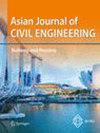Despite having several qualities, the high thermal conductivity of concrete is considered as its shortcoming in tropical and subtropical countries, where temperature may reach a record high of up to 50 °C. This study deals with the experimental and numerical investigations to improve the heat insulation properties of hardened concrete hollow blocks by selecting a suitable insulation material at the ambient temperature range of 35 to 50° C. A total of ninety-six blocks were cast and tested. The dimensions of the outer moulds were 12” × 12” × 6” whereas the dimensions of the inner steel moulds (hollow section) were varied and categorised into three different batches. Each block was stuffed with the loose form of mineral wool which served as an insulating material. After preparation, the blocks were placed in the open air under direct exposure to sunlight. The difference in the temperature on the top and bottom surfaces of the blocks was recorded through several readings with regular intervals of time and compared to measure the amount of heat insulated by the mineral wool. Findings showed that with the temperature rise, insulated large hollow blocks stiffed and resisted more heat than medium and small insulated hollow blocks. It was also found that the control specimen (blocks with no insulation material) insulated less heat than when filled with mineral wool. The heat transfer coefficient for all categories of tested specimens was also calculated theoretically by making variations in the hollow space filled with mineral wool. The maximum temperature difference was more than 20 °C when the ambient temperature was 52 °C. A two-dimensional finite element (FE) model was developed and validated against the experimental results. The FE model showed close agreement with experimental results.


